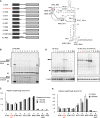UGA stop codon readthrough to translate intergenic region of Plautia stali intestine virus does not require RNA structures forming internal ribosomal entry site
- PMID: 30337458
- PMCID: PMC6298568
- DOI: 10.1261/rna.065466.117
UGA stop codon readthrough to translate intergenic region of Plautia stali intestine virus does not require RNA structures forming internal ribosomal entry site
Abstract
The translation of capsid proteins of Plautia stali intestine virus (PSIV), encoded in its second open reading frame (ORF2), is directed by an internal ribosomal entry site (IRES) located in the intergenic region (IGR). Owing to the specific properties of PSIV IGR in terms of nucleotide length and frame organization, capsid proteins are also translated via stop codon readthrough in mammalian cultured cells as an extension of translation from the first ORF (ORF1) and IGR. To delineate stop codon readthrough in PSIV, we determined requirements of cis-acting elements through a molecular genetics approach applied in both cell-free translation systems and cultured cells. Mutants with deletions from the 3' end of IGR revealed that almost none of the sequence of IGR is necessary for readthrough, apart from the 5'-terminal codon CUA. Nucleotide replacement of this CUA trinucleotide or change of the termination codon from UGA severely impaired readthrough. Chemical mapping of the IGR region of the most active 3' deletion mutant indicated that this defined minimal element UGACUA, together with its downstream sequence, adopts a single-stranded conformation. Stimulatory activities of downstream RNA structures identified to date in gammaretrovirus, coltivirus, and alphavirus were not detected in the context of PSIV IGR, despite the presence of structures for IRES. To our knowledge, PSIV IGR is the first example of stop codon readthrough that is solely defined by the local hexamer sequence, even though the sequence is adjacent to an established region of RNA secondary/tertiary structures.
Keywords: dicistrovirus; internal ribosomal entry site; stop codon readthrough.
© 2019 Kamoshita and Tominaga; Published by Cold Spring Harbor Laboratory Press for the RNA Society.
Figures







Similar articles
-
Conditional rather than absolute requirements of the capsid coding sequence for initiation of methionine-independent translation in Plautia stali intestine virus.J Virol. 2003 Nov;77(22):12002-10. doi: 10.1128/jvi.77.22.12002-12010.2003. J Virol. 2003. PMID: 14581537 Free PMC article.
-
A Stem-Loop Structure in Potato Leafroll Virus Open Reading Frame 5 (ORF5) Is Essential for Readthrough Translation of the Coat Protein ORF Stop Codon 700 Bases Upstream.J Virol. 2018 May 14;92(11):e01544-17. doi: 10.1128/JVI.01544-17. Print 2018 Jun 1. J Virol. 2018. PMID: 29514911 Free PMC article.
-
Characterization of the 5' internal ribosome entry site of Plautia stali intestine virus.J Gen Virol. 2006 Dec;87(Pt 12):3679-3686. doi: 10.1099/vir.0.82193-0. J Gen Virol. 2006. PMID: 17098985
-
Mechanism of translation initiation by Dicistroviridae IGR IRESs.Virology. 2011 Mar 15;411(2):355-61. doi: 10.1016/j.virol.2011.01.005. Epub 2011 Feb 1. Virology. 2011. PMID: 21284991 Free PMC article. Review.
-
Functional analysis of structural motifs in dicistroviruses.Virus Res. 2009 Feb;139(2):137-47. doi: 10.1016/j.virusres.2008.06.006. Epub 2008 Jul 25. Virus Res. 2009. PMID: 18621089 Review.
References
Publication types
MeSH terms
Substances
Supplementary concepts
LinkOut - more resources
Full Text Sources
